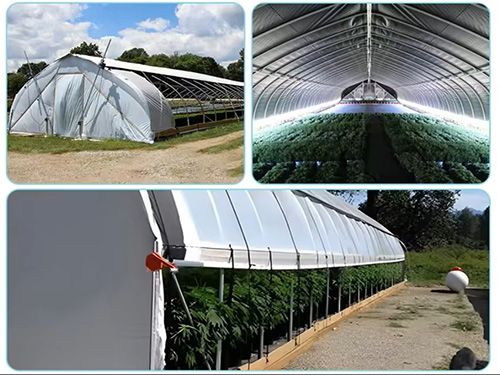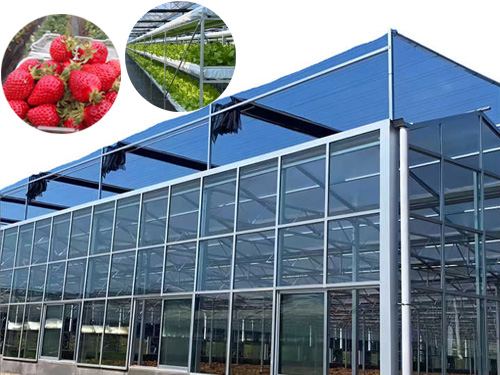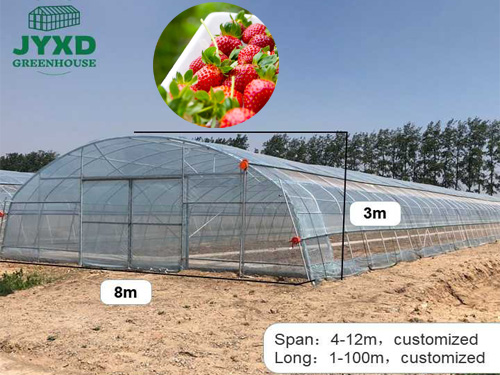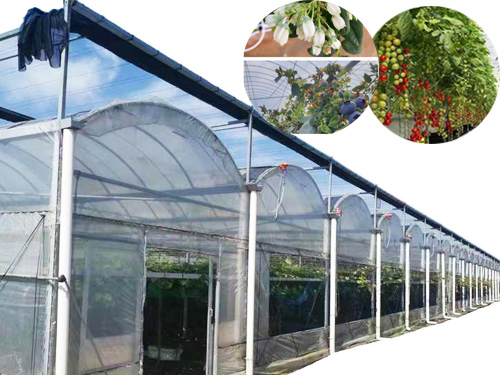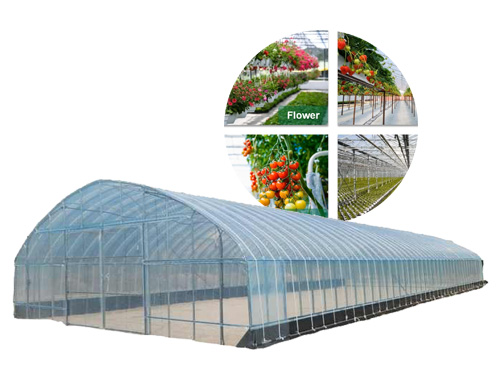NEWS DETAILS
NEWS INFORMATION
Rural Greenhouses: How to Maximize Resource and Land Utilization
AUTHOR:jyxd-greenhouse DATE:2025-03-23 11:10:24 HITS:154
In rural areas, land and resources may be limited, but they also present unique opportunities for sustainable agriculture. Greenhouses, when designed and managed effectively, offer a way to optimize land use and maximize resource utilization while ensuring a steady supply of fresh produce. Whether you are operating a small family farm or a larger agricultural business, maximizing the potential of rural greenhouses can significantly increase efficiency, reduce waste, and enhance profitability. This article explores strategies for maximizing resource and land utilization in rural greenhouses, highlighting the benefits of thoughtful design, resource-efficient practices, and advanced technologies.
1. Strategic Greenhouse Location and Design
The location and design of your rural greenhouse are the first steps toward maximizing land use. Careful planning can help optimize available space, reduce energy consumption, and create an ideal environment for plant growth.
Selecting the Right Location
Choosing the right site for your greenhouse is crucial for its success. Factors such as sunlight exposure, wind patterns, and proximity to water sources should all be considered when selecting a location. Ideally, greenhouses should be placed in areas that receive abundant sunlight throughout the day, as this will reduce the need for artificial lighting and help maintain optimal temperatures for plant growth. Additionally, positioning the greenhouse to take advantage of natural windbreaks, such as nearby trees or hills, can help protect it from strong winds and reduce heating costs in colder months.
Compact and Efficient Greenhouse Designs
In rural areas where land may be scarce or expensive, space optimization is key. Greenhouses should be designed with a compact layout that maximizes the available area. Vertical farming techniques, such as multi-level shelving or stacking systems, allow growers to make use of the full height of the greenhouse, increasing plant density and optimizing space. Additionally, using modular greenhouse systems enables flexibility in expanding or adjusting the structure as needs change over time.
2. Resource-Efficient Irrigation and Water Management
Water is one of the most valuable resources in agriculture, and its efficient use is essential for sustainable farming, particularly in rural greenhouses where access to water may be limited. Implementing effective irrigation and water management systems can help conserve water, reduce costs, and ensure optimal growing conditions.
Drip Irrigation Systems
Drip irrigation is one of the most efficient methods of watering plants in a greenhouse. By delivering water directly to the plant roots, drip irrigation minimizes water wastage and ensures that plants receive the necessary moisture without excess runoff. This system is especially beneficial in rural greenhouses where water sources may be less abundant or costly. Drip irrigation also allows for precise control over water delivery, helping to avoid overwatering or underwatering.
Rainwater Harvesting
In rural areas, where access to municipal water sources may be limited or costly, rainwater harvesting is an excellent solution for collecting and storing water. Rainwater can be captured from the greenhouse roof and stored in tanks for later use in irrigation. This practice not only reduces reliance on external water supplies but also helps conserve water resources, contributing to a more sustainable farming operation.
Water Recycling Systems
Water recycling is another effective strategy for maximizing resource utilization in rural greenhouses. By implementing a water filtration and recirculation system, growers can reuse water that has been used for irrigation, reducing waste and lowering overall water consumption. This system is particularly useful for high-demand crops that require frequent watering, allowing for efficient water use throughout the growing cycle.
3. Energy-Efficient Climate Control
Maintaining a stable climate inside the greenhouse is essential for promoting plant growth and ensuring high-quality crops. However, in rural areas where energy resources may be limited or expensive, it is important to incorporate energy-efficient technologies to reduce heating, cooling, and lighting costs.
Solar Power Integration
Integrating solar power into your rural greenhouse operation can help reduce reliance on external energy sources and lower overall energy costs. Solar panels installed on the greenhouse roof can generate electricity to power fans, ventilation systems, and lighting. In some cases, excess energy generated by the solar panels can be stored in batteries for use during cloudy days or nighttime. By harnessing renewable energy, greenhouse owners can significantly reduce their environmental footprint and operational expenses.
Natural Ventilation and Cooling
Proper ventilation is essential for regulating temperature and humidity inside the greenhouse. In rural areas with temperate climates, natural ventilation can be a cost-effective solution for cooling the greenhouse during hot weather. Strategically placed vents and windows allow fresh air to circulate, promoting airflow and cooling the space without the need for energy-intensive fans or air conditioning systems. Passive cooling systems, such as shade cloths or thermal screens, can also be employed to reduce heat buildup and maintain a stable internal climate.
Geothermal Heating Systems
For colder climates, geothermal heating is an energy-efficient option for maintaining warmth in the greenhouse during the winter months. By tapping into the earth’s natural heat, geothermal heat pumps can provide a consistent source of warmth with minimal energy consumption. This system is particularly beneficial for rural greenhouses located in areas with harsh winters, as it can help reduce the need for traditional heating methods, such as gas or electric heaters.
4. Maximizing Land Use with Multi-Cropping and Companion Planting
Rural greenhouses provide an excellent opportunity to increase crop diversity and maximize land use through multi-cropping and companion planting techniques. These practices not only optimize space but also promote healthy plant growth and improve overall yield.
Multi-Cropping
Multi-cropping involves growing multiple crops in the same greenhouse space, either simultaneously or in succession. By rotating crops and planting different types of plants with complementary growing requirements, greenhouse operators can maximize land use and reduce the risk of soil depletion. This practice also helps increase profitability by diversifying the types of crops grown and extending the harvest season.
Companion Planting
Companion planting is another strategy for maximizing the efficiency of a rural greenhouse. Certain plants grow better when planted together due to their complementary needs or natural pest-repellent properties. For example, planting basil with tomatoes can help deter pests, while planting lettuce with beans can improve soil fertility. By carefully selecting plant pairings, greenhouse operators can optimize space, improve crop health, and reduce the need for synthetic pesticides and fertilizers.
5. Waste Reduction and Sustainable Practices
Sustainability is a key consideration in any agricultural operation, and rural greenhouses are no exception. Implementing waste reduction and sustainable practices not only helps protect the environment but also improves resource utilization and reduces operating costs.
Composting Organic Waste
Composting is an effective way to reduce waste and recycle organic materials in the greenhouse. Plant trimmings, crop residues, and other organic matter can be composted to create nutrient-rich soil amendments. This process not only reduces the amount of waste sent to landfills but also improves soil health and provides a sustainable source of nutrients for future crops.
Recycling Materials
Recycling greenhouse materials, such as plastic pots, trays, and packaging, is another way to maximize resource utilization. By reusing or repurposing materials, greenhouse operators can reduce the environmental impact of their operations and lower costs. Additionally, using recyclable and biodegradable materials for packaging and plant containers can further promote sustainability in the greenhouse.
6. Conclusion
Maximizing resource and land utilization in rural greenhouses is essential for improving efficiency, sustainability, and profitability. By strategically designing the greenhouse layout, implementing efficient irrigation and climate control systems, and employing sustainable practices, growers can optimize available resources and create a productive growing environment. Through careful planning and the adoption of modern technologies, rural greenhouses can become more resource-efficient, reduce waste, and contribute to a more sustainable future in agriculture. Whether you are a small-scale farmer or a larger agricultural operation, maximizing the potential of your rural greenhouse is a key step toward long-term success.
Hebei Juyou Xinda Greenhouse Facilities Co.,Ltd.
Copyright © 2024-2025 https://www.jyxd-greenhouse.com. All Rights Reserved Hebei Juyou Xinda Greenhouse Facilities Co.,Ltd.Copyright





 Current Location:
Current Location:


